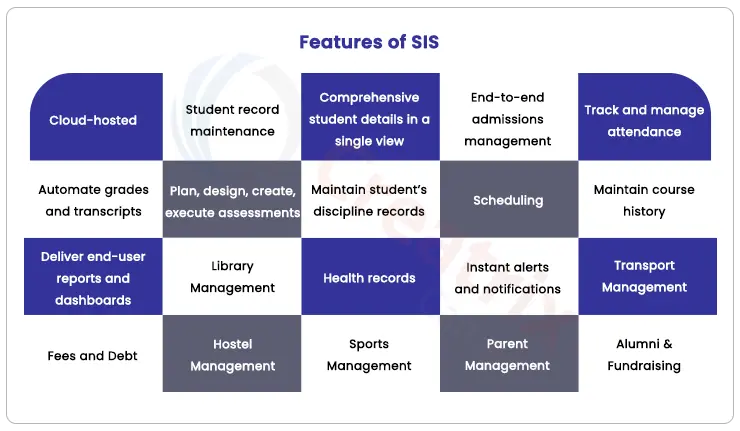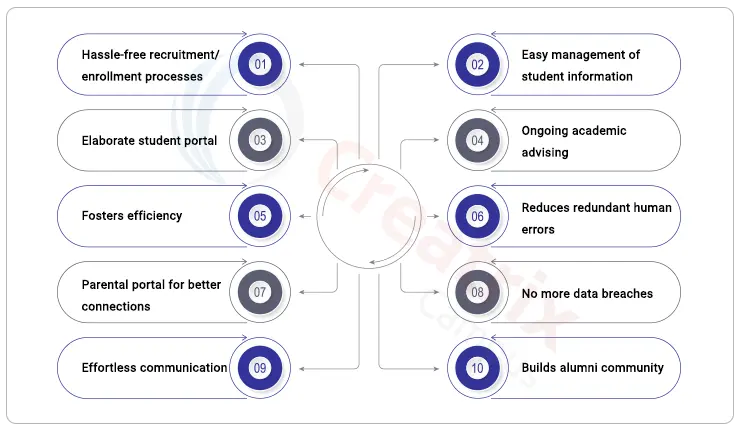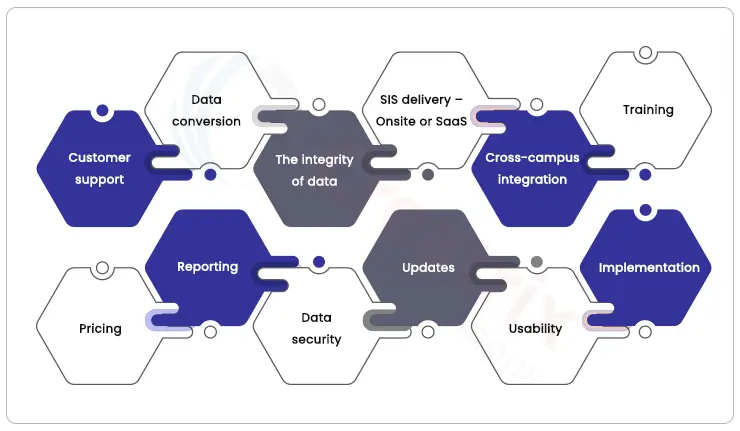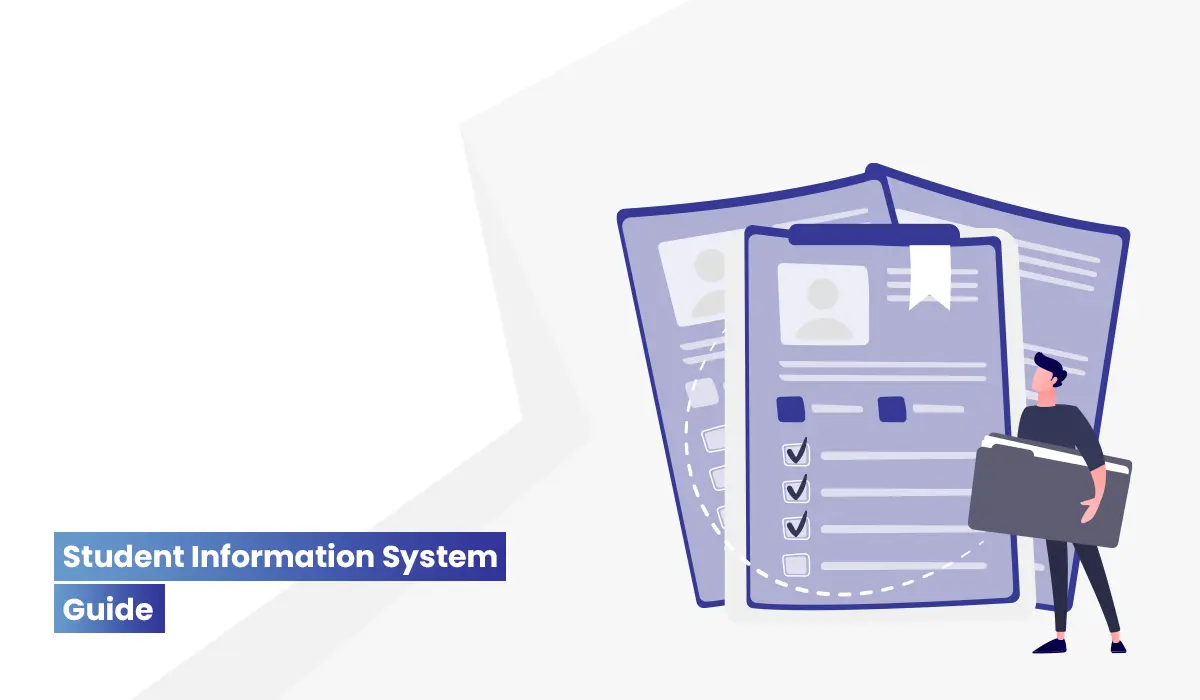Introduction to Student Information System
In today’s fast-paced world, higher education institutional heads have been facing a tremendous challenge meeting out to nurture students' experience; the burden of tracking, organizing, and reporting student data confronts them further. How do they help students to succeed and their institutions thrive in this rapid change?
With admissions, enrolment, attendance, scheduling, grading, placement, communication, and reporting needs, institutions must use smart technology to manage the end-to-end student lifecycle for the efficient running of things. This way institutional heads can take their burden off their shoulders, communicate better with the stakeholders, and achieve their objectives on time.
student information system can become a savior. It is an all-comprehensive solution with top-notch features with oversight on complete learning management, school management, and student information management in a flexible and intuitive web-based platform.
If you would like to learn more, this guide can help you. We have everything you need to understand about the Student Information System here.
What is a Student Information System
A Student Information System (SIS) or Student Information Management System or Student Management System is software that is designed to manage all data related to students right from the day they join until they graduate. It unites every aspect of the Student Lifecycle in a single place under a single, easy-to-use configurable platform. Highly performing SISs today come with AI, mobile, and self-service capabilities to deliver a unique and tailored student experience.
For a glimpse of what we do at Creatrix Student Information System, watch the below video
Student Information System - the latest market stats
Let’s make it more interesting. Let’s pick some numbers to know the current market trend of SIS management. An analysis obtained by Reuters based on key SIS players like Creatrix Campus helps us understand the SIS market growth.
The Global Student Information System (SIS) for Higher Education by Reuters confirms that the SIS Market industry’s size increased by 6.35% from 1631 million $ in 2014 to 1962 million $ in 2017.
Yet another extensive research by MarketsandMarkets affirms that the SIS solution “is expected to hold the largest market size during the forecast period of 2023”. It goes on to speculate that from a 5 billion USD growth in the year 2018, there would be a massive 9 billion USD rise by the year 2023.
.webp)
The SIS users will increase further, competitors will gain greater grounding, and there will be many more improvements and advancements. In short, there will be a “power-packed student information system” that helps higher education and universities meet their institutional mission and individual student’s goal easily.
Why does Student Information System Software matter in higher education?
Student Information Systems cannot be ignored by Higher education institutions for so many reasons. Here are they;
- SIS is designed with a focus on the changing world of education.
- The right SIS helps institutions keep up always and better serve both students and leaders.
- Made for student engagement and collaboration in all moments that matter. It has tools to provide a unique experience unlike any other.
- Features adaptability to change when it comes to diverse programs and distributed student populations.
- Gives real-time insight into the campus with its insightfulness.
- Efficient enough to focus on student success.
- It manages every single data of students in an organized way.
- Eliminates the time taken by faculty in student data compilation.
- Allows faculty to channel their concentration on the students.
Your Guide to Student Information Systems (SIS)
- What is a Student Information System in real life?
- Cracking the Student Information System code - knowing its history
- Features of Student Information System?
- The benefits of a student information system
- What would be the future of the SIS?
- What is a student web?
- SIS Migration
- Are you using the right SIS?
- SIS checklist - how to choose the best Student Information Software
- Creatrix Student Information System
1. What is a Student Information System in real?
Have you heard of a filing cabinet? Something of a large piece of office furniture that is built to store all your documents. The student information system or the student learning hub is similar to that.
The SIS has digital file folders that have thorough information about every single student in an institution, predominantly located in a centralized place.
The best feature of possessing an SIS management is that it lets all the key players of higher education including recruitment, admissions, enrollment, registrar, financial aid, advisors, billing, librarian, and school/student services to easily assess, and add important data from each student's folder.
2. The history of the Student Information System
Present-day higher education has grounds similar to the same economic model exercised in the pre-industrial world. However, with the advent of the Industrial Revolution and the massive change that swept through the education industry, SIS started taking shape.
The inception of the ‘new’ student information system
The 1970s was the time the computerized administrative systems were operated as mainframes. Only highly specialized programmers were only able to handle it. They were surprisingly expensive and rigid. Hence many school districts were not in a position to afford these resources.
By the mid-’80s, there came the arrival of minicomputers with mainframe computing capacity. They still witnessed specialized environments and programming restrictions, making things tough. They lacked flexibility and ease of use, which made school districts still meddle with uncompromising options. That’s when personal computers were launched. Educators were able to relate themselves to the PCs. They found accessing, inputting, and modifying student information easy with the simple drag-and-drop functionality.
Consequently, the PCs made their gradual entry into the public schools. Though initially they were used for instruction, by the Time millennium hit, most of the schools had computers for their administrative use.
The boon that the internet brought
The internet was yet another booming factor of the student data management system software. With the Internet, institutions have easy accessibility and flexibility of browser-based information systems. The trend was bolstered by wired Internet connectivity, allowing educational institutions to use their own systems like the SIS.
At the outset, SIS served as a digital filing cabinet for all the mandatory information that an institution would need to gather about a student. It had a lot of setbacks. The information stored was not real-time and needed pulling out data in bits and pieces every time. Institutions would take a manual process, and then try fitting it with technology to expedite it. The process was still similar to manual work and the scenario was parallel to an old dusty filing cabinet.
At the same time, the school admins were relying on an outdated code base that had a mix of presentation features, data access, and business sense. The adaptability of these systems was still a question. They just served the purpose of fulfilling very few aspects of student management systems.
The Pipeline, WebCT, and Jetspeed were a few to mention. The biggest disadvantage with them was the fact that the student data was scattered in different locations.
That is exactly when educational institutions were waiting for a web-based, user-friendly student information system with certain built-in mechanisms that catered to the purpose of the school management system at the same time meeting the demands of student-related information management.

The real wait for a complete package of student information management systems from a single source remained unfulfilled still.
The present-day SIS - an unexpected change
The present-day student information system is mature with many advanced functionalities today’s students and their parents would prefer. It is designed to target today’s higher education and wipe out the high school student stress and student problems faced by most of them. There is every option to engage the learners, ways to improve, and keep them informed, all in a single go.
Grades and GPAs are calculated with the SIS. It's here that the enrollment/admissions data are stored, academic records are sustained, disciplines are logged, attendance is tracked, students' learning outcomes are measured, placements records are furnished, alumni relationships are sustained, and the fee details are too.

3. Features of SIS software
It is necessary to look into the in-built features of the student information system before investing in it. It is due to its unique characteristics that SIS has helped higher education institutes reimagine themselves. Some valued features of SIS are here.
Cloud-based — A cloud-based student information system is certain to let higher education institutions and their student records safe and secured in a single place
Admissions — A feature that leads the applicant throughout the recruitment process from being a prospect to getting admitted
Student records — Any best school system built on this SIS feature gives a holistic 360-degree view of the student. This includes enrollments for courses, outcomes tracking, etc.
Academic advising — A college student management system with academic advising rightly locates at-risk students and derives customized learning pathways
Financial aid — Tailored and automated options for financial aid and scholarships
Reporting — Dynamic dashboards that give an edge over-reporting, allowing institutions to make timely decisions
Registration and scheduling — Most school information management software comes with built-in course registration and scheduling features, allowing students to do their jobs themselves.
Communication — Any college student management system ensures seamless communication between stakeholders with a set of communication tools
Billing - Information related to transactions and fees is securely done
Analytics — In-built analytics enable the institutions to visualize, understand, and work with the key data that is most relevant to them
Gradebooks and transcripts — The grading system in India is comprehensive as like the US grading system and other countries. This is hence one of the most important features that help to maintain a comprehensive grade book for all of the students'
Student portal — A place where students track performance, attendance, and grades in the portal. This ensures an open channel for communication between various stakeholders
Parent Portal — Today’s higher education SIS software comes with a parent portal, letting parents be informed of their children’s A-Z and indulge in faster communication
Alumni & fund-raising — Bringing together an influential alumni network for fund-raising, membership, career advancement, curriculum development, and placement-related aspects

4. The benefits of a student information system
SIS is a one-stop source to manage all kinds of student information by easily integrating with other modules. Thus it is given more importance when it comes to student data management these days. Here are the 10 ultimate benefits of the Student Information System.
- Hassle-free recruitment/enrollment processes
- Easy management of student information
- Elaborate student portal
- Academic advising
- Fosters efficiency
- Reduces redundant human errors
- Parental portal
- No more data breaches
- Effortless communication
- Builds Alumni

5. The future of the SIS
It is indeed true that there is a metamorphosis of change that is affecting the delivery of education. At the most basic level, student characteristics and expectations are shifting, therefore the SIS should too! The future SIS is going to be a bundle of startling transformations, benefitting both traditional and non-traditional learners alike.
Such upheavals and changes are going to get common in the days to come and SIS is no exception. There is going to be a major shift in SIS, hence the future SIS is going to be a bundle of startling transformations, benefitting both traditional and non-traditional learners alike.
There have been several predictions on what the future SIS would seem like.
Apart from being smart, streamlined, cost-efficient, and more predictive, the SIS would develop an ability to handle tons and tons of data. Massive data handling would happen including those of students, course load, tutors, and many more.
The accumulation of this data would ultimately help both the institution and those involved as stakeholders. Students would be nudged in the right direction to achieving better outcomes, and advisors and support faculty would be better guided to assist students in achieving success. Besides, the college student information system in the forthcoming days will be absolutely future-ready. Here are a few ways by which it can leave a huge impact.
- AI might be the most dominating feature of future SIS
- Machine learning and language recognition can add to personalizing the student experience
- Faster and strategic implementation, saving campus leaders, students, and staff enough time to taste the plethora of features and SIS come with
- Greater detailing with positive digital disruption that adds tangible value to all stakeholders
- Power-packed support services throughout the implementation process
- The SIS implementation providers would be equipped with top-notch knowledge, the right experience, agility, sector requirements, and cultural context with the incorporation of present-day technology
- A much integrated SIS that places the student at its heart with an improved user experience would evolve
- Every detail of an SIS application, admissions, through assessment and grades would get to only support, guide, and enhance the student experience
- A very adaptive and scaffolding SIS that adapts to the initiatives proposed by the universities, communities within, administrators, students, and the support staff.
6. What is a student web portal?
Designed specifically for students, the student web portal is an integral part of any higher education or university.
It is a student connect login page that gives the student a view of everything present within. All that the student is expected to do is to unlock and get inside with his/her user credentials shared. Once in, the student gets to access all the institution's programs, student resources, and online teaching/learning materials which include articles, lectures of classes missed, videos, gets to know his performance, report cards & transcripts, track his attendance, performance, course details, notifications, and reminders. Beyond academics, the student also gets information regarding special events, student calendars, fee details, and schedules. In short, there is nothing that an SIS student service portal lacks.
The real need for the student web arose with the advent of larger classrooms, with faculty getting less accessible to each one of them. It is almost similar to a student help center that propagates a direct line of communication.
With a student web portal, there is healthy communication between the teachers/students/administration all in a single place.
The biggest advantage of the student portal is especially with students who show hesitancy to clarify their doubts in class. Intimidated students can do the same through the portal and receive instant explanations.
7. SIS Migration
When there comes a situation of divorcing your old SIS for the new one, many higher eds still panic. Here are the most common reasons for it:

When there comes a situation of divorcing your old SIS for the new one, many higher eds still panic. But there are still those who don't even know their SIS needs to change.
Here are 5 warning signs indicating your SIS’s demise.
- Lack of integration between LMS and other modules
- Current SIS is very basic and not robust
- Lack of linking to outcome-based education and accreditation
- Improper student portfolios
- Lack of comprehensiveness
- Existing SIS with a high price tag
If you have any of the above signs, then you need to switch for a change.
The SIS market is no longer the same. Providers these days aim at keeping the institutions in the driver’s seat, not the passenger seat. Regardless of any legacy systems that you own, they are ready to offer immediate access and take complete ownership when it comes to migration, ensuring you get the best of both worlds.
8. Are you using the right SIS?
If you were of the view that the student SIS can only give benefits, you could be mistaken. With an insufficient SIS comes a lot of stumbling blocks.
There had been reports and instances showing failures of using improper SIS, with no proper implementation plan and support system.
Schools Supt. John Deasy acknowledged that grades, assignments, and even students have been disappearing from computer system records, and it could take a year to work out kinks in the system just to enter grades.
This instance was with a particular school in Los Angeles, where the school experienced an unexpected drawback with its SIS failing to throw out information about their students. The school system went through its rough pace due to this glitch. Neither students were able to track their attendance or grades, nor were the faculty able to figure out the students who were enrolled in the class.
An SIS that cost more than $130 million became a “technological disaster” for them. There have been several similar records where many such higher education institutions have let go of their legacy systems because of their rigidity in meeting the institutional goals.
In the present day, the student information system’s drawbacks are minimized and well-ironed to a great extent. But the key lies in picking the right one. Hence, if you come across an SIS that is really feature-full, easy to use, cost-efficient, and with an assurance given on data protection, grab it.
9. SIS checklist - how to choose the best Student Information Software?
With an aim to improve the quality of education and keep expenses to a minimum, higher education institutions are keen on implementing a solution that aligns with their operational efficiency. But with the fleet of SIS offerings available in the market, how to select the best one? Here are some best-of-the-breed features that you should look into before making your decision.

Customer support: An SIS with responsive customer service is crucial. It matters the most when you encounter an issue and would want a timely resolution.
Data conversion: Implementing a successful SIS is expected to maintain your prevalent institutional data and business rules. There can be no compromise on that. Prepopulating data can be entrusted to a proven provider and should be done thoroughly.
The integrity of data: This will be the second important factor to look into if you aim to maximize your institution’s efficiency. Any data concerning the institution should be relevant, universal, and lastly secure. Check for the SIS’s built-in database technology that provides access to information, storage, and protection of all your critical data and applications.
SIS delivery: Checking for the SIS delivery mode helps. Providers take the option of hosting SIS by themselves or letting you manage and host the same from your system, right from your campus. SaaS or Software as a Service is a pay-as-you-go solution that comes with minimal upfront costs, eliminating other miscellaneous fees. With SaaS, you really don’t buy a system, but rather use all its services. With such a SaaA self-hosting, your institution can manage its very own computer environment, backups, security, necessary updates, etc.
Integration across campus: A SIS that promotes functional integration between departments works best. Such an SIS should allow cross-departmental communication, allowing sharing of data and student records seamlessly.
Training: Training is as inevitable as the implementation itself. With adequate training received, you should be able to use the application to its fullest, reaping its full benefits.
Pricing: Pricing matters as much as the other factors of concern. The SIS service provider whom you choose should be responsive to your needs. Payment should be flexible including budget constraints and choice of delivery options.
Reporting: An SIS should come with reporting and analysis tools when it comes to measuring institutional effectiveness.
Data security: The security of the database can never be compromised. The SIS provider you choose should be sensitive to the institution’s data concerning students and staff.
Updates: An SIS that doesn’t support the newest updates doesn’t fit your needs. Technology is evolving and so is higher education.
Usability: The SIS should own an interface that influences how best you use it. Of the many, it should be configurable, and efficient enough to share data between departments, and manage and store institutional data in a centralized single location.
Implementation: A perfect plan in place by the project management team stating the complete implementation plan matters. In cases of prepopulating data, the data conversion should be done smoothly.
10. Moving forward with Creatrix’s Student Information System
Creatrix Campus can be the right transformative partner in enabling you to achieve your strategic goals seamlessly. Our Student Information System can help you integrate with other systems and leverage your digital technology.
SIS by Creatrix Campus is created with state-of-the-art technology and educational expertise to connect students, faculty, parents, and administration for ease of the process. Our SIS is 100% configurable, for we absolutely understand that no two institutions work the same and give you the option to configure your own system adhering to your specific needs. If you like our Creatrix Campus SIS and would like to integrate it at your institution, please contact us. Our team of experts can help you get it on board.
Want to contribute?
We welcome thought leaders to share ideas and write for our blog.
Become a Guest Author →

